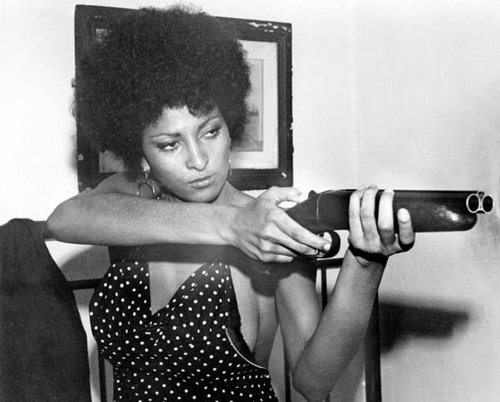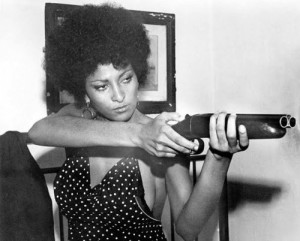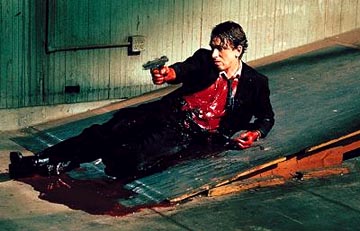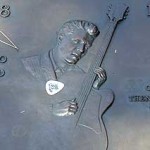Coffy (1973)
Directed by Jack Hill
Every single part of popular culture sort of ripples out like the waves from a bunch of pebbles tossed into a pond that intersect with each other in odd ways. Once a film is made, it is there to be influenced by in varying economic and social strata forever.
My friend invited me to see Roy Ayers tonight. Ayers did the soundtrack to this movie so I decided to watch it. I’m not really that familiar with the Blaxploitation era and I’m not even sure what to think of Coffy since I’ve seen hundreds of films influenced in some way by it over the past 40 years or so.
This is a low budget movie about the inner city. They probably made numerous pornographic films in the ‘70s for more money and its acting has a lot in common with that in the movie Deep Throat. The entire movie was made in 18 days.
It’s essentially Dirty Harry as played by Pam Grier, but shockingly even Dirty Harry seems chaste compared to Coffy. Coffy has tons of sex, nudity and violence in it. Whether or not it is actually also a commentary on drugs and life in inner city black neighborhoods, is probably lost in all of that.
Can you make an effective inner city cautionary tale that is realistic and also have lots of naked women and heads blown away by shotguns? I have seen Superfly. Curtis Mayfield’s soundtrack was definitely a mature contemplation of the evils and pitfalls of inner city life, but the movie it came from seemed to almost glamorize that life.
Pam Grier plays Coffy, a nurse who decides to kill everybody in the heroin business after her sister loses her mind doing drugs. It’s filled with flashy pimps and features a lot of crime, murder and sex. Aside from one black man who plays a sympathetic cop and is beaten half to death for it, every other character in this movie is either Pam Grier or seriously involved in the inner city drug and prostitution trade.
Robert Townshend was born in 1957 and would make Hollywood Shuffle in 1987. Keenan Ivory Wayans was born in 1958 and his take on this era was 1988’s I’m Gonna Git You Sucker.
Wayans’ movie was pretty much a pure parody of these films, which if nothing else usually had great soundtracks made by extremely talented black artists. Townshend’s film loves making fun of this era too, but it’s a little angrier. Hollywood Shuffle was a statement about black actors no longer wanting to be stuck in such stereotypical low budget bull shit anymore. Shuffle, itself, was made so cheaply that it was financed with Townshend’s credit cards.
Quentin Tarantino was born in 1963. His race and his age made him see these movies in a completely different way than Wayans and Townshend did. Tarantino loved these movies. He didn’t see them as a thing to be either somewhat amused or offended by, to Quentin Tarantino these were rides into an outlaw life that he could never really begin to understand, but one which he clung to as not just lurid and exploitative, but foreign and exciting. He especially loved that the hero was an extremely sexual woman, and indeed the opening credits to Coffee play from the view of a car’s passenger seat. The movie took Tarantino on an exciting ride.
When he got to make Jackie Brown (1997) with Pam Grier, he didn’t see it as a funny call back; he was star struck and armed with an encyclopedic knowledge of every single shot of every single one of these movies. Tarantino’s directing debut Reservoir Dogs featured the following scene:
Mr. Pink: What was the name of the chick who played Christie Love?
Nice Guy Eddie: Pam Grier.
Mr. Orange: No it wasn’t Pam Grier. Pam Grier was the other one. Pam Grier did the film. Christie Love was like the Pam Grier TV Show without Pam Grier.
Mr. Pink: So who was Christie Love?
Mr. Orange: How the fuck should I know?
Mr. Pink: Great. Now I’m totally fucking tortured.
I was born just a couple of years later than Tarantino, but for some reason I never saw these movies. Regrettably my entire youth from 1980 when I entered high school to 1988 when I finished college was presided over by Ronald and Nancy Reagan. So I pretty much missed most of this stuff.
Back in the ‘80s it felt like everyone in the 1970s was on a huge coke binge. People’s clothes just seemed crazy and outrageous. What then seemed embarrassing now seems fascinating and exotic. Instead, I grew up on music videos and coming of age sex romps that now seem extremely immature and absurd. The first movie that I ever got into underage was 1982’s Porky’s, and I spent plenty of time scrolling through cable channels looking for brief shots of nudity for probably my entire teenage years.
The masterpiece of that Reagan era sex film was 1983’s Risky Business, which expertly parodied the get rich quick, flashy car thinking of the times, but I saw a ton of other movies that were in some ways really infantile about sex. The closest I had ever come to this kind of sexuality was Prince’s movie Purple Rain, which stood apart from the rest of the era in that Prince wasn’t just out for the night hoping to see some nudity. He was actually having sex. Sure, it was with someone named Appolonia, but it was far more realistic and mature than what was apparently going on in the suburbs of a John Hughes movie. That makes sense because Purple Rain took place in the city.
I envy Tarantino, because this movie is far more exciting and sexy than what I was up late watching on Cinemax from 1982-1984. Those movies were all about losing one’s virginity, whereas these were movies where people were having real, experienced sex, or at least that’s how it feels now.
Other things that shaped my view of the world then were body building, fake breasts, cartoonish violence, and superhuman car chases. The movies were fueled by tons of flashy video game, music video editing that now feels so artificial and forced. So now looking back at Coffy, it doesn’t look cheap and silly. It actually feels more real than what came after it.
I know how absurd it is that there are so many fights between women in this movie that are designed to have the top of their dresses ripped off, but it’s not the hyper stylized fighting that you would see in something like the Drew Barrymore version of Charlie’s Angels. Because of its low budget and grittier setting, what was once probably perceived to be awkward one take chaos, now actually feels realistic.
That’s what it would look like if two sexy women were really fighting, and yeah isn’t it cool that they don’t have chiseled bodies that look like they were made out of the same plastic as a Barbie doll. They look clumsy, but that’s probably how real fights between women would actually look, especially in a world where every single woman is either a prostitute or someone who needs to use her sexuality in order to get by.
So Tarantino legitimately falling in love with a movie filled with colorfully dressed pimps, awkward but somehow realistic feeling fights and car chases, and starring a stunningly sexy, shotgun toting Pam Grier makes total sense, and puts him in a long line of white artists reinterpreting the black world and imitating black artists that they worshiped through the prism of the suburbs or at least some other economic reality.
This was directed cheaply by a white man for a black audience so it probably wasn’t ever really meant to be watched and revered like Tarantino does, but his take on the era and what followed gave us grittier, more realistic crime films full of colorful anti-heroes. Whether or not this film is a statement against the ills of the urban inner city didn’t really matter to Tarantino. It was filmed stylistically; its language was hard core and its crime milieu remains endlessly fascinating.
What Tarantino added to the genre was varying takes on both real and cartoon violence, as well as the magic of his reworking of the perhaps originally hackneyed dialogue into his own fevered, sociologically challenged poetry. It doesn’t matter whether anyone in the streets ever really talked like they do in a Quentin Tarantino movie, he just wished that they did and he had the chops to make it both exciting and electric.
Colors (1988) was seen in my suburban world as a somewhat serious look at black and Spanish gang culture. I saw it and was fascinated and saddened by the bleak outlook and savage violence. John Singleton who was studying film at the time at USC hated it. When he opined that it was nothing like the real world that he had grown up in, he was told that the movie was authentic because Ice-T had done the soundtrack. Singleton’s reply was that Ice-T hadn’t been involved in the storytelling and in response made 1991’s way more realistic Boyz in the Hood. That was followed by The Hughes brother even more depressing and realistic film Menace II Society. The only thing those movies shared with Colors were their equally intriguing use of rap music.
Those films were likely made possible by the career of Spike Lee, whose early movies were very authentic views of black life fueled by the fine cinematography of Ernest Dickerson, and a lot of that is alive in Coffy, yet Spike Lee is to this day appalled by Tarantino’s love of these movies especially his seemingly joyous use of the N word.
Spike Lee makes movies that were influenced not only by what had come before but by the real ethnic experiences he saw in his world. Quentin Tarantino makes movies about movies by sampling from all the other movies that he loves. To Spike Lee an artist like Tarantino is slumming through his reality and exploiting it, which is sort of true, but Tarantino is genuinely in love with this genre of movie making. He’s not looking at his characters with any kind of irony or parody at all.
Samuel L Jackson made his mark in early Spike Lee films and is now almost guaranteed to be in every single Tarantino movie that will ever be made. So whereas you used to have Robert Townshend saying that it was insulting to play inner city stereotypes, now you have black actors dying to work with Tarantino in exactly those parts.
Now I’m watching Coffy through my adult eyes after having seen the myriad of different avenues that different filmmakers both black and white have delved into this genre for over 40 years. It’s been parodied; it’s been worshiped; it’s been made more and less realistically, it’s been covered in minute voyeuristic detail on cable television, and the only thing I can really say for sure about Coffy is that Pam Grier was really hot, kicked a lot of ass, and the soundtrack was great. This movie has aged infinitely better than the Hair Metal music videos I grew up on have.








